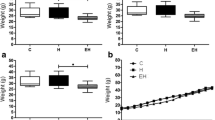Summary
The aetiology of incomplete adrenergic denervation and reduction in the number and caliber of the cerebral vessels in hydrocephalus is still obscure. Stretching of the blood vessels alone is far from explaining these major vascular changes. Previous studies have shown that increased lipid peroxidation produces toxic effects on vessels. This experimental study was designed to investigate the possible aetiology of vascular changes in hydrocephalic rats with special reference to lipid peroxidation.
Hydrocephalus was induced by injecting 50 mg/Kg sterilized kaolin suspension into the cisterna magna in 10 rats (Group A). A sham operation was performed for Group B. After three weeks the rats were anaesthetized and perfused transcardially. The brains were dissected, and cut to visualize the degree of hydrocephalus. The arteries of the circle of Willis were removed for light microscopic examination and the brains were kept for the measurement of lipid peroxidation levels. Light microscopic studies of cerebral arteries in hydrocephalic rats revealed spastic vessels with folding and corrugation of the lamina elastica. The level of lipid peroxidation in group A (260±9.129 nmol TBAR/gr wet tissue) was significantly higher than that of group B (106±3.59 nmol TBAR/gr wet tissue). It is suggested that vascular changes observed in hydrocephalic rats may be due to the high level of lipid peroxidation, which in turn may be the consequence of ischaemia caused by the hydrocephalus related stretching of cerebral vessels.
Similar content being viewed by others
References
Bigio MRD, Bruni EJ (1988) Changes in periventricular vasculature of rabbit brain following induction of hydrocephalus and after shunting. J Neurosurg 69: 115–120
Brooks DJ, Beaney RP, Powell M, Leenders KL, Crockard HA, Thomas DGT, Marshall J, Jones T (1986) Studies on cerebral oxygen metabolism, blood flow, and blood volume, in patients with hydrocephalus before and after surgical decompression, using positron emission tomography. Brain 109: 613–628
Caner H, Caner B, Turul H, Ozcan OE, Erbengi G, Bekdik CF (1991) Pre- and postoperative assessment of regional cerebral blood flow in hydrocephalus by 99 m Tc-hexamethyl-Propylenamine oxamine SPECT. J Nucl Biol Med 35 (2): 66–72
Caner H, Oruçkaptan H, Bolay H, Kilinç K, Senaati S, Benli K, Ayhan A (1991) The role of lipid peroxidation in the genesis of vasospasm secondary to subarachnoid haemorrhage Kobe. J Med Sci 37(1): 13–20
Caner H, Peker S, Ozcan OE (1991) Effects of hydrocephalus on the sympathetic nerves of cerebral arteries, investigated with WGA-HRP anterograde tracing in the rat. Acta Neurochir (Wien) 111: 143–146
Hassler O (1964) Angioarchitecture in hydrocephalus. An autopsy and experimental study with the aid of microangiography. Acta Neuropath 4: 65–74
Higashi K, Asahisa H, Ueda N, Kobayashi K, Hara K, Noda Y (1986) Cerebral blood flow and metabolism in experimental hydrocephalus. Neurol Res 8: 169–176
Hill A, Volpe JJ (1982) Decrease in pulsatile flow in the anterior cerebral arteries in infantile hydrocephalus. Pediatrics 69: 4–7
Koide T, Neichi T, Takato M, Matsushita H, Sugioka K, Nakano M, Hata S (1982) Possible mechanism of 15-hydroperoxy, arachidonic acid induced contrations of canine basiler artery in vitro. J Pharmacol Exp Ther 221: 481–488
Kontos HA, Wei EP, Cristman CW, Levasseur JE, Povlishock JT, Earl EF (1983) Free oxygen radicals in cerebral vascular response. Physiologist 26: 156–169
Lindvall M, Owman C (1984) Sympathetic nervous control of cerebrospinal fluid production in experimental obstructive hydrocephalus. J Exp Neurol 84: 606–615
Oka N, Nakada J, Endo S, Takaku A (1986) Angioarchitecture in experimental hydrocephalus. Pediatr Neurosci 12: 294–299
Penfield W (1929) Cerebral pressure atrophy In: Penfield W (ed) Proc Ass Res Nerv Ment Dis Intracranial pressure in health and disease, Vol 6. Williams and Wilkins, Baltimore, pp 346–361
Perez CA, Hodges FJ, Margulis AR (1964) Microangiography in experimental cerebral oedema in rats. Radiology 82: 529–535
Sasaki T, Wakai S, Asano T, Watanabe T, Kirino T, Sano K (1981) The effect of a lipid hydroperoxide of arachidonic acid on the canine basilar artery. J Neurosurg 54: 357–365
Southorn P, Poowis G (1988) Free radicals in medicine. I. Chemical nature and biologic reactions. Mayo Clin Proc 63: 381–388
Southorn P, Poowis G (1988) Free radicals in medicine. II. Involvement in human disease. Mayo Clin Proc 63: 390–408
Tamaki N, Kusunoki T, Wakabayashi T, Matsumoto S (1984) Cerebral haemodynamics in normal pressure hydrocephalus evaluation by 133 Xe inhalation method and dynamic CT study. J Neurosurg 61: 510–614
Uchiyama M, Mihara S (1978) Determination of manonaldehyde precursor in tissues by thiobarbituric acid test. Anal Biochem 86: 271–278
Wozniak M, Mclone DG, Raimondi AJ (1975) Micro-and macrovascular changes as the direct cause of parenchymal destruction in congenital murine hydrocephalus. J Neurosurg 43: 535–545
Author information
Authors and Affiliations
Rights and permissions
About this article
Cite this article
Caner, H., Atasever, A., Kilinç, K. et al. Lipid peroxide level increase in experimental hydrocephalus. Acta neurochir 121, 68–71 (1993). https://doi.org/10.1007/BF01405185
Issue Date:
DOI: https://doi.org/10.1007/BF01405185



